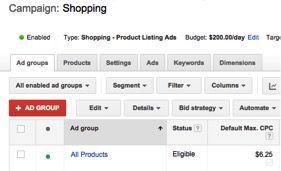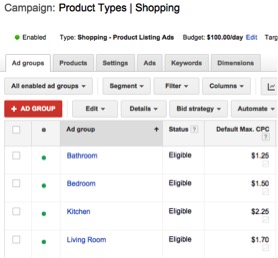If you are running AdWords Shopping campaigns do any of these questions apply to you?
- Do you look at your current campaigns and feel dread as you can’t remember which product or brand is where?
- Are you spending too much time doing routine tasks because your Shopping campaign layout is confusing?
- Are you unsure of how to best structure your Shopping campaigns based upon your needs and goals?
Well, you’re in luck. We’re about to dive into ways to structure your Shopping campaigns based on your needs. You just might find some new ways to impress your friends with a Shopping campaign structure that would make a paid search pro weak in the knees.
We’ll cover three basic strategies for structuring your Shopping campaigns and the reasoning behind each. At the end, you should have at least a basic understanding of how to structure your campaigns to your goals and situation.
Let’s break down the three types of Shopping structures.
- Single campaign with a single ad group (single product focus)
- Single campaign with many ad groups (multiple brands/product types)
- Many campaigns with many ad groups (multiple brands/product types with separate budgeting needs)
Depending on your needs and account strategies, your Shopping campaigns will more than likely fit into one of the above layouts. These are merely the foundation to think about your structure, not an exhaustive list of every possible way to organize. Though we’ll be focusing on AdWords, these suggestions apply to Shopping campaigns on other platforms as well.
Single Campaign with a Single Ad Group

Say you sell the best blanket known to mankind and you really want to get your super awesome blanket in the hands of the world. You’ve also heard about these things called Shopping campaigns. What is an awesome blanket dealer supposed to do?
Queue the single campaign, single ad group structure. It’s fast, it’s easy, and it gets your awesome blankets all over Google’s search pages. You simply create a single Shopping campaign, add the relevant settings, and create a single ad group. Set up your product group within that ad group which shouldn’t be too elaborate since you sell a single product.
This structure is great for ecommerce accounts that sell a single or very few items that don’t need a more complicated structure. It does not hold up well if you have lots of products of varying types and brands that you want in the campaign, especially if you want to track performance easily at the brand, type, or product level.
Pros
- Easy to set up
- Easy to monitor performance
Cons
- Difficult to segment out performance if you have lots of products/brands
- Single budget pooled among your entire feed
Single Campaign with Many Ad Groups

Now lets say you sell not only the best blanket in the world, but you’ve branched out into other product types: pillows, sheets, comforters, etc. Each of these product types has its own profitability goals and the bids your willing to make on each type is going to be different.
By separating them into different ad groups you can clearly see performance by product type at the ad group level. This can make tracking performance data that much easier when it comes time to report back to your boss or client. Plus you have the added benefit of putting negative keywords in each ad group without affecting all your other categories. For example, you may add “blue” as a negative keyword in the pillows ad group since you don’t sell any blue pillows.
The single largest drawback is all of your ad groups and product groups are drawing from a single budget. If one product group goes spend happy, it can use up your budget (depending on its size) preventing other product groups and targets from getting clicks.
Pros
- Ability to segment out performance by type or brand for easy reporting
- Use of negative keywords is more targeted
Cons
- All ad groups share the overarching campaign budget
Many Campaigns with Many Ad Groups

How do we overcome the one issue with the single campaign and multiple ad group structure? Easy, we just break those product categories or brands into their own campaigns with a dedicated budget. Now each campaign houses the product type or brand, while the ad groups can focus on individual products and/or categories (blanket at the campaign level; cotton, flannel, silk, etc. at the ad group levels as an example).
Now you can see brand or product type performance easily at the campaign level and then dive deeper in that brand at the ad group or product group level.
Pros
- Product brands or types have their own dedicated budget
- Easy to see segmented performance for tracking and reporting
Cons
- Most time consuming to set up
- Can quickly become overwhelming depending on the amount of brand/products
Conclusion
So there you have it. Three basic Shopping campaign structures that can help you get the most out of your shopping experience. Take a few minutes to take stock of what you want out of your own Shopping campaigns and what your needs are, then begin structuring your campaigns.



